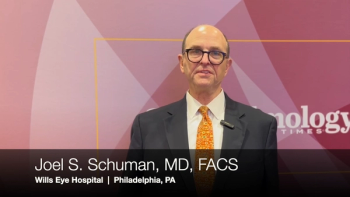
Cefuroxime: intracameral versus subconjunctival injection methods
Intracameral injection of cefuroxime significantly reduced the risk of endophthalmitis following cataract surgery when compared with subconjunctival injection in a single-center study.
Key Points
Sunderland, England-In the first study to directly compare the efficacy of intracameral and subconjunctival injections of cefuroxime (Ceftin, GlaxoSmithKline) in reducing the incidence of endophthalmitis following cataract surgery, the intracameral route was superior in efficacy and shown to be a safe alternative, said Patrick Yu-Wai-Man, MRCOphth.
The results showed 0.46 incidents of presumed infectious endophthalmitis (PIE) per 1,000 cases in the group of patients receiving intracameral injections versus 1.39/1,000 cases among patients receiving injections by the subconjunctival method. The average rate of PIE from 2000 to 2006, the period studied in this retrospective analysis, was 0.95 per 1,000 cases.
Dr. Yu-Wai-Man, of Sunderland Eye Infirmary, Sunderland, England, and colleagues at that center conducted the study using data that had been collected prospectively as part of the unit's ongoing endophthalmitis surveillance program.
Endophthalmitis is a feared complication of cataract surgery for a very good reason. Even with the best management, patients who develop this condition may end up with poor visual outcomes and visual acuities of 20/200 or less. Estimates of incidence vary from a low of 0.5/1,000 cases to as high as 3.6/1,000 cases. Worldwide, the average is about 1.3/1,000, he said.
Given the risks posed by endophthalmitis, prevention is a high priority among cataract surgeons. Various antibiotics are used for prophylaxis, and these may be administered in topical, subconjunctival, or intracameral form, and, by a small number of surgeons, in the form of oral antibiotics or added to the irrigating solutions intraoperatively, Dr. Yu-Wai-Man said. He added, however, that practice guidelines issued by ophthalmic groups or healthcare organizations do not necessarily recommend a specific antibiotic or method of use.
In 2006, the results of a landmark study carried out by the European Society of Cataract and Refractive Surgery (ESCRS) provided clinicians with more detailed recommendations. The ESCRS Study of Prophylaxis of Postoperative Endophthalmitis after Cataract Surgery showed that the injection of intracameral cefuroxime at the end of cataract surgery reduced the incidence of endophthalmitis by nearly fivefold. This randomized, placebo-controlled, partially masked study enrolled 16,603 patients and was carried out at 24 clinical centers in 9 European countries. The trial investigators concluded that a regimen of prophylactic intracameral cefuroxime could significantly reduce the rate of endophthalmitis to below 0.08%.
The results of the ESCRS study were consistent with those of a study conducted in Sweden using the national registry data for cataract surgery. Not having an intracameral cefuroxime injection at the end of the procedure was associated with a seven times higher risk of endophthalmitis in cases performed between 2002 and 2004. In Sweden, only 1% of cataract procedures are performed without intracameral cefuroxime, Dr. Yu-Wai-Man noted.
"Should we all be moving to an intracameral cefuroxime injection at the end of surgery? It's not as straightforward as this, and there certainly is quite a lot of controversy, especially around the ESCRS trial," he continued. Some clinicians have questioned the exceptionally high rate of endophthalmitis reported in that study among patients who did not receive intracameral cefuroxime. The rate was 3.3/1,000, which is much higher than was previously reported; in North America and Europe, the rate is generally 1.4/1,000 cases or less.
Reluctance to change
Dr. Yu-Wai-Man also observed that up to 83% of ophthalmologists in the United Kingdom use subconjunctival cefuroxime injections following cataract surgery. Many UK ophthalmologists logically question why they should switch to an intracameral route when they have achieved an acceptable endophthalmitis rate with their current approach.
His study was designed to address such issues, asking which method was better and whether intracameral injection of cefuroxime was a safe alternative. The study was carried out at Sunderland Eye Infirmary, which is a 23-bed, dedicated eye hospital in the northeast of England staffed by 16 senior consultants.
From Jan. 1, 2000, to Nov. 16, 2003, all patients undergoing cataract surgery received a subconjunctival injection of cefuroxime at the end of the procedure. Following a protocol change on Nov. 17, 2003, patients instead received an intracameral injection of the drug. The rate of PIE between the two groups of patients was compared using Chi-squared test with Yates correction for categorical data.
There were 19,425 cataract procedures involving subconjunctival injection and 17, 318 with intracameral cefuroxime. Dr. Yu-Wai-Man reported that there were 27 cases of endophthalmitis (1.39/1,000) in the subconjunctival group and 8 (0.46/1,000) in the intracameral group. There was a statistically significant threefold drop in the risk of developing endophthalmitis following the change in protocol.
The culture positive rate was 15/27 (55.6%) in the subconjunctival group and 6/8 (75%) in the intracameral group. To date, there have been no reported complications from the use of intracameral cefuroxime at the Sunderland Eye Infirmary.
Newsletter
Don’t miss out—get Ophthalmology Times updates on the latest clinical advancements and expert interviews, straight to your inbox.



















































.png)


